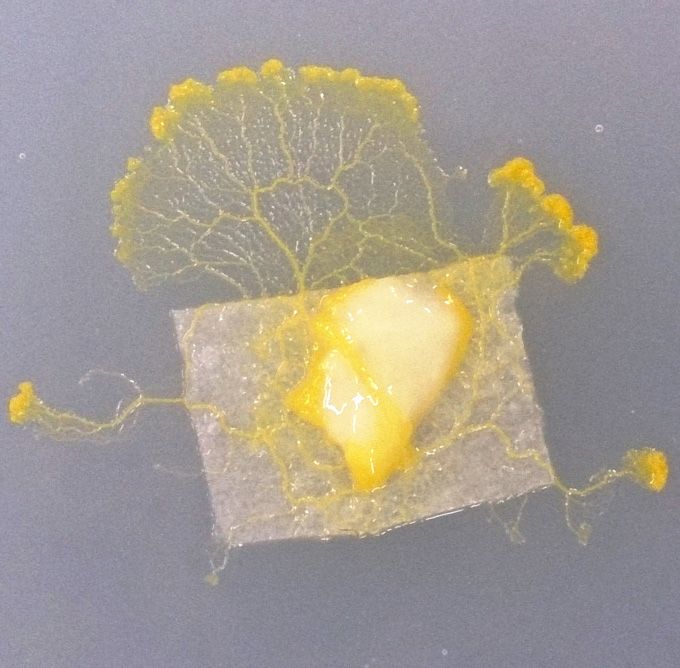
Japan’s Ig Nobel Prize Winners Show Path of Scientific Progress Is Not Always Straight
Science Technology- English
- 日本語
- 简体字
- 繁體字
- Français
- Español
- العربية
- Русский
Maze-Solving Molds
Are banana peels really slippery?
Is it possible to extract vanilla fragrance from cow dung?
The Ig Nobel Prize is awarded for study into these kinds of amusing topics. Since 1991, the US publisher Improbable Research has put the spotlight on “research that makes people laugh and then makes them think.” It honors 10 achievements each year.
Japan is regularly represented among the award recipients and has provided at least one winner for each of the past 10 years. This abiding presence includes the Japanese scientists who investigated the two questions above. Where do their offbeat ideas come from? I will consider this question while looking back at the history of the Ig Nobel Prize.
In 2008, a team led by Nakagaki Toshiyuki of Hokkaidō University won the Cognitive Science Prize for research on slime molds. These sticky organisms may not appear to have any special abilities, but Nakagaki’s team showed that one particular variety—Physarum polycephalum—was able to “solve” mazes. Perhaps even more amazing was that researchers had the idea to test it. So how do the slime molds do it?
 Yellow Physarum polycephalum mold surrounds a food source (center).
Yellow Physarum polycephalum mold surrounds a food source (center).
Slime molds move slowly toward their food. If there are multiple sources of food available, they construct a network of tubes, like blood vessels, that connect them to one another. A thick liquid known as protoplasm flows along the tubes, carrying nutrition throughout the network. These tubes can provide the solution to mazes.
In the experiments, the researchers first spread food all over the maze so the slime mold would spread along every path. When it had done so, they removed most of the food sources, leaving them only at the start and the goal. The tubes remained on the path from beginning to end, but gradually withdrew from other areas, thereby revealing the shortest route to solve the maze. In applying mathematics and biology to deciphering this phenomenon, Nakagaki’s team opened up a new field of scientific research.
 Diagram showing how slime molds solve mazes.
Diagram showing how slime molds solve mazes.
Keep It Down Over There!
A further example comes from 2012.
In that year, Kurihara Kazutaka and Tsukada Kōji of the National Institute of Advanced Industrial Science and Technology received the Acoustics Prize for the development of the SpeechJammer. This device is a nonaggressive means of getting people to shut up. Everyone has had the experience of sitting in a meeting while a colleague endlessly prattles on or of being in a library or other quiet place and wanting someone to stop talking without getting into an argument. Kurihara turned his attention to this everyday annoyance—until then neglected by science.
The SpeechJammer consists of a unidirectional microphone that records sound from only one direction and a speaker that transmits sound only in that direction. When pointed at an unwelcome babbler, it records his or her voice and broadcasts it back with a slight delay. The off-putting effect of hearing their own words is enough to cut short the targets’ verbiage.
 The SpeechJammer has a silver microphone that is attached on top of a large black speaker.
The SpeechJammer has a silver microphone that is attached on top of a large black speaker.
This phenomenon of “delayed auditory feedback” has long been known, but Kurihara applied it in a humorous way to deal peaceably with a common irritant.
Slow and Steady
The Ig Nobel Prize highlights eccentric ideas that most people have not considered. But where do they come from? It is difficult to come up with a simple answer to this question, but an essay written by a Japanese researcher over 80 years ago provides some hints.
Terada Torahiko (1878–1935) was a physicist, remembered today for his research in areas like X-ray crystallography, a cutting-edge field at the time. He is also known as an accomplished essayist who observed everyday life from a scientific perspective. His works are still read now, principally by university students.
In his 1933 essay “Kagakusha to atama” (Scientists and Intelligence), he writes the following.
“One has to be intelligent to become a scientist.” This is the standard assumption made by the general public. In a sense, it is true. At the same time, the proposition, “One has to be unintelligent to become a scientist,” is also, in a sense, true.
It is commonly assumed that scientists are very bright. They must have the analytic ability to accurately observe and understand complexly intertwined natural phenomena. What does it mean to say that they need to be “unintelligent”? Terada goes on.
People who are intelligent are like fleet-footed travelers. They may be able to reach uncharted territory before anyone else, but they might miss an important spot lying by the wayside or on a side road. Dull-witted, plodding travelers may need more time to reach the same destination, but they are more likely to bump into these treasures.
The research by the Ig Nobel Prize winners introduced above perfectly fits this description. By focusing on as yet ignored areas, they were able to make new discoveries. Is this kind of research trivial? Not necessarily, Terada insists.
When they hit upon a new idea, brilliant scholars often dismiss it even before it is tried because they assume that the expected results would not be worth their effort. But unintelligent scholars are incapable of calculating such odds. Instead, they work frantically on a topic that appears to be of no value, pressing forward with total absorption. And as they do so, they not infrequently make an unforeseen but important finding. In these cases, the brilliant scholars give too much credit to the human mind, forgetting the unbounded depths of the natural world. In general, nobody knows the value of scientific results until it emerges. Such value is commonly only recognized 10 or 100 years after the results are published.
From Potential to Realization
With continued hard work, apparently trivial research can also bear fruit. This is what happened with the slime molds and the SpeechJammer.
Nakagaki’s team thought that the maze-solving molds could help with urban planning by finding the best routes for roads and railways. The team made a map of Japan from kanten (agar jelly), placing food sources at the locations of major cities near Tokyo. Growing slime molds on top of this created a structure very similar to the existing rail network. Research on the mathematical structures of slime molds could help develop new simulation methods. This work won a second Ig Nobel prize for the team in 2010, this time in the Transportation Planning category.
Having developed the SpeechJammer, in 2014 Kurihara formed the Special Interest Group on Shyness and Hesitation Around You, which researches “shyhack” technologies for people who find it difficult to communicate. The group seeks to reduce the psychological burden of staying in touch, including such problems as social media fatigue. It has produced such tongue-in-cheek ideas as a party design system for people who worry too much about what other people think of them.
There is no proof that Terada Torahiko’s words have provided direct inspiration to any of the Ig Nobel Prize-winners. But it is certain that the freedom found in the Japanese research environment, as characterized in “Scientists and Intelligence,” has greatly stimulated the imaginations of the nation’s researchers. I look forward to many more surprising discoveries from such “unintelligent” scientists.
(Originally published in Japanese on February 22, 2017. Banner photo: Professor Higashiyama Atsuki of Ritsumeikan University, Kyoto, receives the Ig Nobel Perception Prize for “investigating whether things look different when you bend over and view them between your legs.” Japanese scientists have been awarded an Ig Nobel Prize in each of the past 10 years. © AP/Aflo.)
